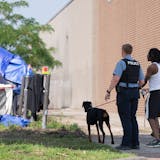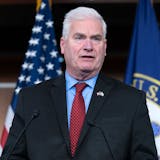St. Paul's Newell Park was largely deserted on a recent cold and rainy Saturday, except in one corner, where a bunch of people were dodging behind oak trees, filling the air with flying foam darts and the constant "phut! phut! phut!" sound coming from the brightly colored plastic toys they were holding.
At first glance, it looked like kids playing with Nerf guns, except most of these people were grownups. And lots of them were carrying foam-dart devices that didn't come out of a Hasbro factory.
"We admit we're grown people playing with toys and there's nothing wrong with that," said Autumn Eule-Nashoba, a member of the Minnesota Nerf Community Facebook group, which has about 300 members.
Eule-Nashoba is one of a growing number of Minnesotans who take foam-dart shooting seriously, who spend hundreds of dollars on custom, high-tech, high-performance toys, who build up collections of 200, 300 even 500 "blasters" (they don't call them guns). In a quest to create devices that fling foam faster and farther, they even build their own blasters with 3-D printers and PVC tubing and test dart speeds with electronic chronograph devices.
Many are aiming to have a souped-up blaster capable of flinging a foam dart at least 200 feet per second, or nearly 140 miles per hour, about two or three times that of a typical store-bought Nerf blaster.
The hobby appeals to tinkerers who like to expand the limits of the devices with stronger springs, more powerful batteries and barrels lubricated with furniture polish.
"We're attempting to get more energy out of the system," Eule-Nashoba said.
It's also a hobby that attracts collectors who prowl through Goodwill and other thrift stores looking for cheap, secondhand Nerf blasters that could be fun to modify or might have value as a collectible.

